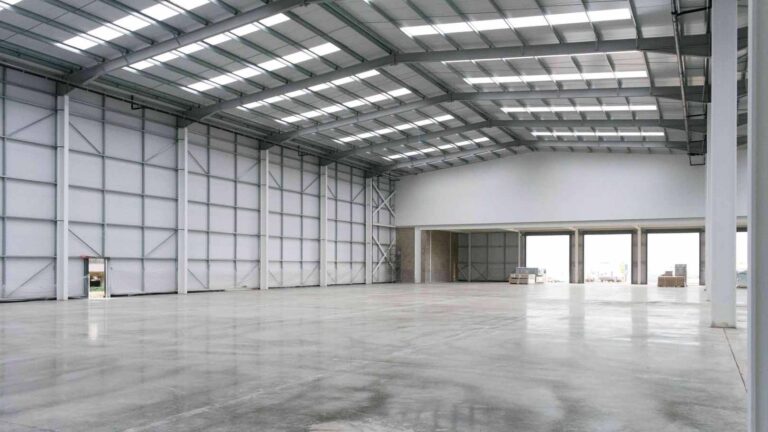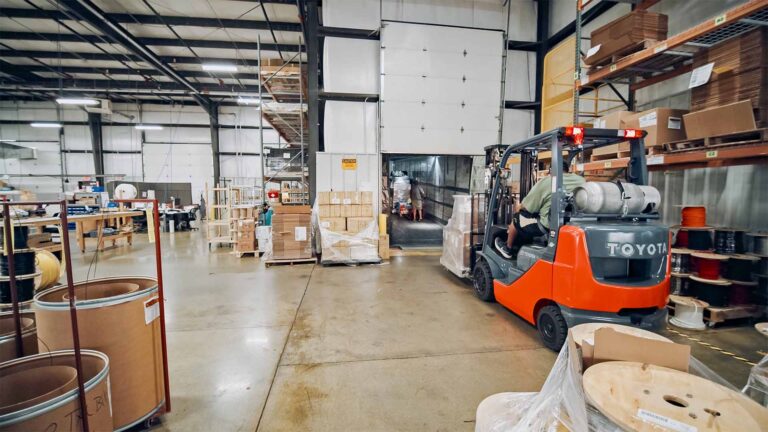
Warehouse Design Guide: Layout & Tips for Efficient Warehousing
The various factors in warehouse layout design and how to decide what is right for you based on your business needs.
In the ever-evolving realm of ecommerce, staying one step ahead involves optimizing processes by employing an effective Order Management System (OMS). What is an OMS and how can it help a business? To answer these questions, this article will provide an overview of order management systems, their components, as well as tips to choose and implement the right solution for your company.

Having the right order management system in warehouse can dramatically improve operations with better accuracy and reduced costs while making sure to meet customer expectations.
The effectiveness behind this type of software solution allows businesses to not only provide timely delivery but also improve stock control and other important metrics for order processing. Let’s examine how these systems work and why they are so beneficial for e-commerce brands and fulfillment warehouses worldwide.
An Order Management System (OMS) is a software solution that simplifies and optimizes the process for receiving, tracking, and fulfilling customer orders. Order management systems help automate tasks which helps improve accuracy and efficiency.
The order management process starts when customers place their orders online or through other mediums. Usually, a successful payment triggers the order to send to the warehouse where they are picked up packed into containers before being dispatched to recipients. All of this is facilitated by OMS technology which keeps everyone updated on every step taken real-time.
It’s nearly impossible to stay competitive in today’s marketplace without some kind of order management system. Automating tedious processes and streamlining order delivery simultaneously improves customer satisfaction and minimizes labor costs. Without this, it would be highly difficult to maintain the level of service that consumers expect, at least at scale.
Systems such as these also unlock a swath of reporting capabilities. These help warehouse managers make educated decisions based on real process data and identify problem areas. When integrated with other platforms such as CRM or finance management systems, a comprehensive automated solution can be provided that yields reporting on the ROI from the or management process itself.

There are several main functions that an OMS is responsible for. All these pieces have a vital role to play in making sure that the entire procedure of dealing with orders runs effectively and without interruption. The core components of an order management system are:
In the next paragraphs, we will discuss every aspect related to OMS so you get more understanding concerning what role they perform and why these functions are essential for achieving success in overall order management process optimization tasks successfully conducted through said system’s implementation strategy.
Integrating sales channels into an Order Management System (OMS) is essential in order to effectively consolidate orders from a variety of sources. This creates one streamlined platform where all customer communications, product purchases and payments are efficiently managed for increased satisfaction. It allows businesses to gain access to vital data about their sales performance, which can be utilized for better decision-making as well as driving growth opportunities. All these elements together result in improved efficiency that ultimately will benefit the customer experience too!
An efficient inventory management system is an integral part of any order management system (OMS). This helps to ensure accurate stock levels, preventing out-of-stock situations and controlling the cost associated with it. With such a tool in place, businesses can observe real time info regarding their inventories, making more informed decisions on refilling stocks and filling orders while keeping customer satisfaction at optimal rates by avoiding scarcity or overstocking cases.
By implementing this OMS along with robust inventory control systems companies gain the ability to monitor stocking conditions accurately whilst reducing operational costs through lower risk for backorders.
Through the implementation of an OMS, businesses can optimize order fulfillment and processing to reduce labor costs while boosting cash flow. This automation streamlines the entire process from purchase placement all the way through delivery – resulting in increased customer satisfaction due to reduced errors, as well as a more efficient and profitable operation that will benefit long-term success.
The advantages of linking a Customer Relationship Management (CRM) system to an Order Management System are undeniable. By efficiently managing customer data, personalized marketing and better client service are made possible, which in turn leads to improved customer satisfaction and loyalty. Integrating these two systems could lead to cost savings through automation as well as allow access for informed decision-making based on the gathered information about customers such as their communication patterns or experiences with your product/services.
All this frees up resources allowing businesses not only to enhance customer relationships but also focus more attention on growing their brand and developing new products too!

It is critical for a businesses or warehousing providers wanting to enhance their operations and improve customer satisfaction that they select the right order management software. In this article we will be offering advice on how you can pick out an appropriate OMS for your organization, considering different aspects such as features offered, contrasting between cloud-based and onsite systems plus costs/ROI calculations. By keeping in mind these criteria when making a decision, it guarantees that you get an OMS which adheres to all of your business goals while maximizing value at the same time.
When looking for an OMS that is the best fit for your business, it’s essential to take into consideration its features and capabilities. Aspects such as central order management capacity, compatibility with multiple payment gateways, inventory control capability, integration with fulfillment partners and customer handling should all be considered when making a decision.
By researching different options in terms of their functionalities, you can guarantee obtaining maximum value from one that meets all of your company’s needs, this will ensure better productivity along with cost reduction which ultimately leads to organizational success.
When deciding between cloud-based and on-site OMS solutions, scalability, accessibility, and cost of upkeep should be taken into account. Cloud offerings are more flexible when it comes to adapting according to a company’s needs due to their remote access via an internet connection. Whereas on premises arrangements necessitate the acquisition of additional hardware and software in order to extend capacity, they may only be accessed within the physical premises.
In terms of maintenance costs too, there is a difference: with cloud options these expenses tend towards lower expenditure as businesses do not have to pay for or maintain any infrastructure themselves. Keeping all this information at hand one can make an informed decision about which type of solution suits best your business operations, either cloud based or go down the path of an On Premises strategy accordingly.

When choosing an OMS, it is critical to review both the expenditure and potential return on investment so that it matches your financial plan as well as business targets. Pricing can vary substantially among vendors, features and implementation prerequisites with some solutions costing from $1K – 5K per month while other reasonably priced options are available at around $100 monthly.
By carefully weighing up the fees of dissimilar OMS selections in correlation to their likely ROI you will be able to ensure making a wise decision which not only provides adequate capabilities but also gives maximum value for money for your company.
After selecting the perfect order management system (OMS) for your business, it’s time to move forward with implementation. Making sure that this step goes smoothly requires you to link the OMS up with your goals and other systems in place as well as provide training for staff members. Following good planning strategies will enable success – leading to more efficient operations, lower costs and improved customer satisfaction rates.
This guide will present advice on how best to go about implementing an OMS. Emphasizing tips along every step of the process so you are able to make certain its value is realized by your organization through cost savings and greater patron fulfillment levels.

To make sure the Order Management System you choose meets the needs of your business, it is important to ensure that its implementation aligns with key objectives. Sales and order processing can be streamlined as well as stock levels managed in a more efficient way when tailored specifically for an organization’s requirements.
Order fulfillment, inventory control and securing orders cost-effectively are all essential areas which need consideration during OMS implementation. This will enable successful setup from the outset. When these goals are properly identified up front, they should then be applied throughout the process accordingly so organizations can reap maximum rewards going forward.
Having the OMS work in conjunction with existing business systems like CRM, finance management and supply chain is necessary to ensure efficient data exchange. To make this integration successful, it’s important to synchronize all channels’ information as well as connect the OMS with other software that runs your e-commerce fulfillment stack for smoother operations while leveraging meaningful insights from gathered data. This will assist you when managing orders, inventory and customer relationships so a complete solution can be put into place.
Proper training and assistance during the integration of an OMS is essential for staff to understand how it works optimally. This not only facilitates a successful launch, but also gives employees the capacity to maximize its features, leading eventually to increased efficacy, savings in cost as well as customer satisfaction.
Training can take multiple forms, including webinars, online sessions and extensive documentation available. Plus, ongoing support should be provided so any queries or issues are addressed while familiarizing with the system. Investing resources into instruction and guidance will make sure that implementation runs smoothly all along using your OMS successfully afterwards.
Warehousing plays a critical role in the supply chain and e-commerce operations, offering advantageous qualities such as greater customer service levels, affordability and risk mitigation. Companies should gain knowledge about warehousing to make the right choice of solution for their needs. Embracing fresh ideas from within the ever-changing warehouse sector can provide businesses with an edge against competition in today’s market.
Order management involves capturing, tracking and fulfilling customer orders in their entirety. This includes all aspects of the process from when an order is placed up until it has been delivered to its respective customer while also allowing businesses access to crucial delivery visibility resources. The ultimate objective is for customers to receive exactly what they ordered without any issues or delays along the way – thus providing a smooth end-to-end fulfillment experience that caters well towards satisfied buyers.
Order processing for both B2B (business to business) and B2C (business to consumer) involves different complexities. When it comes to handling B2B orders, the process usually contains order entry, confirmation of purchase, payment execution along with other steps necessary for fulfillment. On the contrary, when dealing directly with a customer – from individual buying up to small businesses or organizations – this activity is normally much simpler yet still requires certain procedures that are usually less customized.
The Order Management System is designed to make it easier and faster for businesses to manage customer orders, from taking them in through tracking them up until they are fulfilled. It helps streamline the entire process of receiving, monitoring, and delivering these purchases.

The various factors in warehouse layout design and how to decide what is right for you based on your business needs.

There are many different types of warehouses. Choosing the appropriate warehouse type is important for the effectiveness of your business.

Discovering the 6 most costly warehouse mistakes and the simple preventative ways to fix and avoid them all together.
There was a time when businesses revolved centrally around the customer and their needs. Decisions were made based on what is best for the customer first. People did what they said they would, and jobs were completed on time. AMS carries on the tradition of customer service today.
AMS is a customer service-centric warehousing and fulfillment company. We have the software, but we don’t replace PEOPLE and SERVICE with software. Being that we are a contract manufacturer as well, we have a lot of expertise and capability that you can rely on and trust.